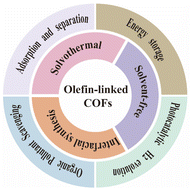Olefin-linked covalent organic frameworks: synthesis and applications
Abstract
Covalent organic frameworks (COFs) with high specific porosity, easy functionalization, and tailored structure are an emerging class of crystalline porous polymers that have been extensively exploited as ideal materials in various fields. Among them, sp2-carbon linked COFs with high chemical stability, porous backbone, and unique π-electron conjugated architectures structure have raised widespread attention. Specifically, the porous channels of olefin-linked COFs could be packed with active sites for catalysis and guest molecules, while π–π stacking interactions and conjugation systems pave the way for electron transfer. In recent years, many efforts have been devoted to the development of sp2-carbon linked COFs for applications in catalysis, energy storage, gas adsorption, and separation. In this review, we highlight the design principles, synthesis strategies, and impactful applications of olefin-linked COFs. We are looking forward to this review to deepen the understanding of the synthesis of olefin-linked COFs and motivate the further development of these novel conjugated organic materials with distinctive physicochemical properties, as well as their applications in a variety of fields.

- This article is part of the themed collections: 2023 Frontier and Perspective articles and New Talent: Asia Pacific


 Please wait while we load your content...
Please wait while we load your content...